#tlacopan
Text



#kemetic dreams#brownskin#brown skin#asian culture#east asians#asian american#aztec#Nahuatl#tenochtitlan#texcoco#tlacopan#aztec empire#aztlan
203 notes
·
View notes
Photo
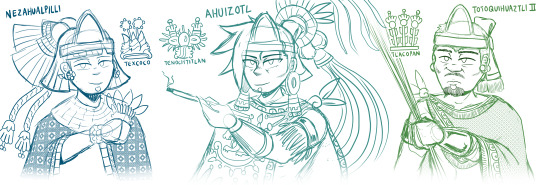
The Triple Alliance Tlatoque
I was sketching the two remaining kings of the Triple Alliance, and decided to throw in Ahuizotl as well to have the three together.
The lords of Texcoco, Tenochtitlan, and Tlacopan, by 1493 CE.
#CodexBlack#CodiceNegro#sketch#tlatoani#tlatoque#TripleAlliance#aztec#mesoamerica#mexico#Character Design#ahuizotl#nezahualpilli#texcoco#tenochtitlan#tlacopan#totoquihuaztli
114 notes
·
View notes
Text
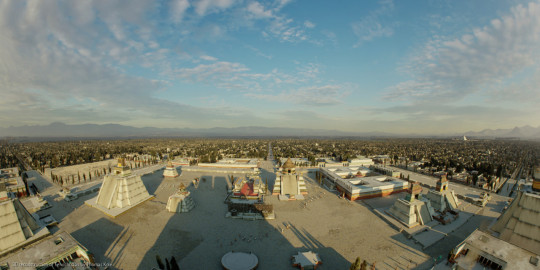

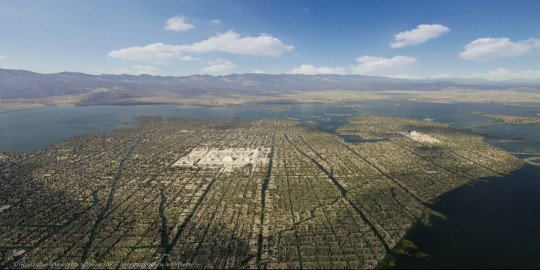
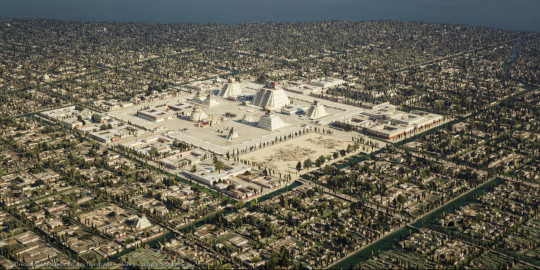


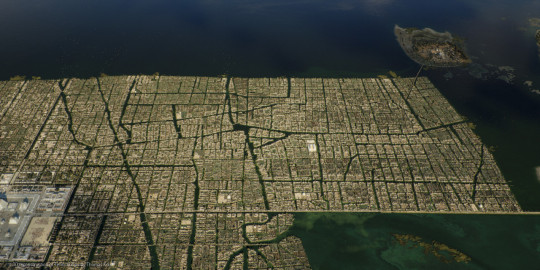



3D Reconstruction of Tenochtitlan, the ancient mexicas Capital city
4 notes
·
View notes
Text
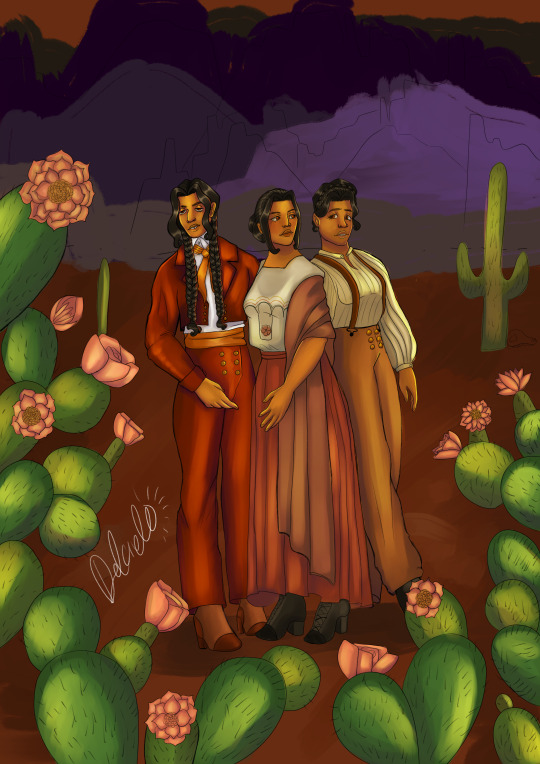
I had the amazing opportunity to be a part of the Wild Westalia Zine hosted by the wonderful @michichi69 !
This is my piece featuring my OCs, Huitzilihuitl (Tetzcoco), Xochitl (Tlacopan), and Tematlalehua (Tenochtitlan).
#hws#hetalia#hws tetzcoco#hws tlacopan#hws tenochtitlan#hetalia oc#hetalia ocs#yaqa draws#hetalia world stars
39 notes
·
View notes
Text
//this blog is still alive I swear. Send asks and I’ll answer away!
1 note
·
View note
Photo
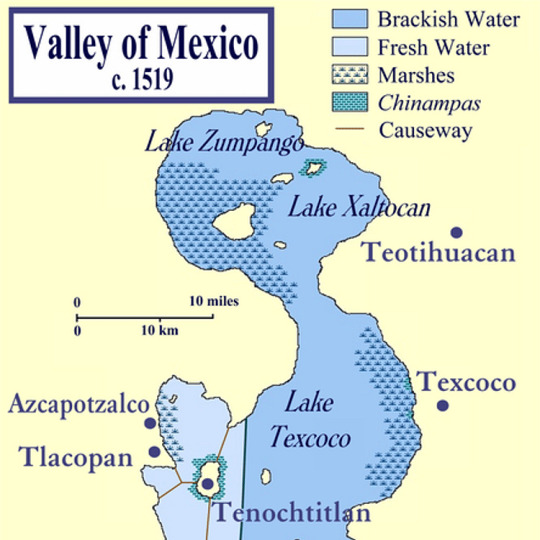
Texcoco
Texcoco (Tezcoco o Tetzcoco), ubicada cerca de la orilla orientale del lago de Texcoco en el valle de México, fue la capital del pueblo Acolhua. Fue una gran potencia durante el período azteca y un miembro de la Triple Alianza junto con Tenochtitlan y Tlacopan. Texcoco también es el lugar de nacimiento de uno de los gobernantes más famosos de Mesoamérica, Netzahualcoyotl, quien presidió a una ciudad que llegaría a ser un renombrado centro de cultura y aprendizaje.
Leer más...
16 notes
·
View notes
Text
Over the years, archaeologists have unearthed many offerings at the Templo Mayor, located at the heart of the ancient Aztec, or Mexica, capital of Tenochtitlán and adjacent to contemporary Mexico City’s cathedral. The most recent, the 186th to date, was announced in August: a stone chest filled with objects from the sea and 15 anthropomorphic sculptures in green stone, dating from the reign of Moctezuma Ilhuicamina (1440–69).
The discovery was made by archaeologists Alejandra Aguirre Molina and Antonio Marín Calvo, working under the direction of Juan Ruiz Hernández of the Proyecto Templo Mayor—an ongoing restoration effort focused on one of the great archaeological landmarks of ancient Mexico. It was founded by Eduardo Matos Moctezuma in 1978 not long after utility workers discovered a statue of the Aztec goddess of the moon, Coyolxauhqui, at the Templo Mayor site. The initiative is currently directed by archaeologist Leonardo López Luján.
The offering was left on a platform on the rear facade of the Huei Teocalli, to use the Nahuatl name for the Templo Mayor, a few centimeters away from an area impacted 123 years ago by the placement of a sewage pipe. The offering box includes 14 anthropomorphic male sculptures and one female figurine. This artifact dates from the time of the first Moctezuma to rule Tenochtitlán, in the middle of the 15th century.
According to the researchers, the sculptures carved from green stone exhibit characteristics of the Mezcala style from the northern highlands of the Mexican state of Guerrero, about 200 miles south of Mexico City. Among these sculptures, one that is 30 centimeters high stands out in contrast to the other figurines that are as small as 3 centimeters tall. All have some unique features, and the style of the figures and their origin in the state of Guerrero has led the archaeologists to speculate that they arrived at the Templo Mayor following the Aztec conquest of the region.
Like all Aztec rulers, Moctezuma I Ilhuicamina, whose full name in Nahuatl is Motēuczōmah īlhuihcamīna, was a powerful leader of the civilization which had its capital at Tenochtitlán. He ruled between 1440 and 1469 and was the fifth tlatoani, or ruler of Tenochtitlán. Moctezuma I expanded the territory of his empire through a series of military campaigns and conquests. During his reign, the Triple Alliance (which consisted of Tenochtitlán and the nearby cities of Texcoco and Tlacopan) succeeded in conquering several neighboring peoples and expanding its influence in the Mesoamerican region.
In addition to his military achievements, Moctezuma I is remembered for his focus on the cultural and religious development of Tenochtitlán. He promoted the construction and decoration of many temples and monuments, including the Templo Mayor, the most important ceremonial center of the Mexica civilization.
“When the Mexica subdued these peoples, the figurines were already relics, some of them are more than 1,000 years old, and presumably served as cult effigies, which the Mexica appropriated as spoils of war,” explains Luján.
Aguirre and Marín, who also worked with Sofía Benítez Villalobos, a specialist in restoring artifacts, have concluded that, after they were brought to Tenochtitlán, the sculptures underwent a ritual that transformed them and incorporated them into the religious life of Tenochtitlán. They point to traces of facial painting that the Mexica added to the figurines, associated with the god of rain, Tlaloc.
In addition to the sculptures, offering 186 included two earrings in the shape of rattlesnakes and a total of 137 beads made of various green stones, accompanied by sand and 1,942 different elements from the ocean including shells, snails, and corals.
Originally from the coasts of the Atlantic Ocean, a region subdued by the Triple Alliance in the time of the first Moctezuma, the seashells have been restored, and the responsibility for their biological identification lies with Belem Zúñiga Arellano, a member of the Proyecto Templo Mayor team.
The discovery of this offering builds on archaeologists’ interest in verifying a pattern observed in earlier offerings, specifically 18, 19, and 97. These consisted of stone chests that were buried as part of dedication offerings under monumental serpent heads located on the platform of the Templo Mayor. All these offerings may provide a better understanding of how the Aztecs viewed the Templo Mayor.
“In the classic Nahuatl language, these chests were known as tepetlacalli, from tetl, or stone, and petlacalli, a box made of mats. In their homes, the Mexica would store their most precious belongings—fine feathers, jewelry, and cotton garments—in chests made from petate (a type of palm). If we look at the Templo Mayor, which represents a sacred mountain full of provisions, we can imagine the priests storing in these ‘stone chests’ the quintessential symbols of water and fertility: sculptures of the rain gods, green stone beads, shells, and snails,” López Luján explains.
By 2024, the Proyecto Templo Mayor plans to ask the Archaeology Council of Mexico’s Instituto Nacional de Antropología e Historia, the government body that administers all of the country’s archaeological sites, for permission to temporarily remove a serpent's head located on the northern side of the Templo Mayor. It is likely that even more treasures will soon see the light of day again.
5 notes
·
View notes
Photo
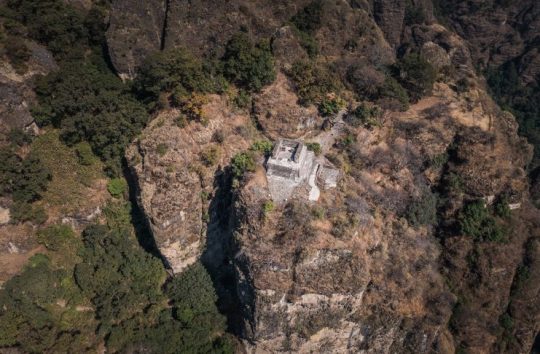
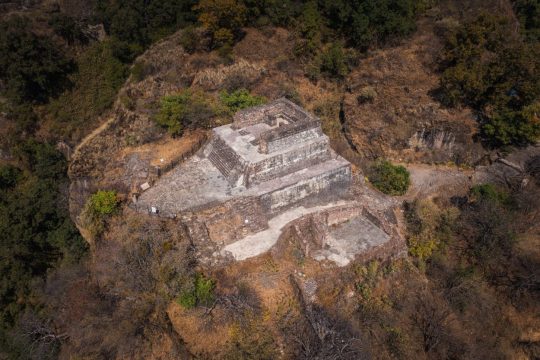
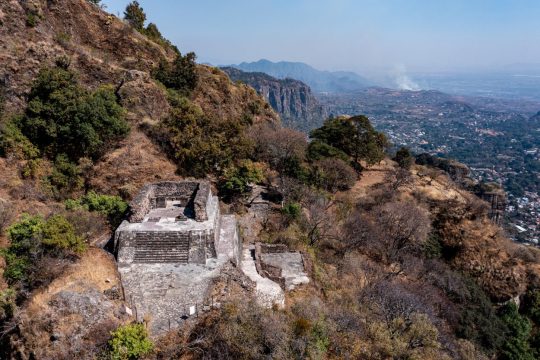
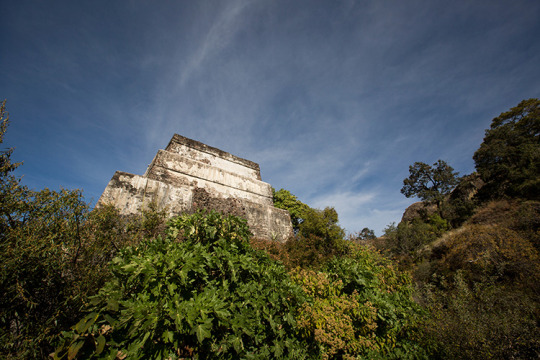
El Tepozteco – The Temple of the Drunken Aztec Rabbit
El Tepozteco is a remote Aztec temple, built on one of the peaks of the Sierra de Tepoztlan in Morelos, Mexico.
The temple is dedicated to Ometochtli-Tepoztēcatl, an Aztec god associated with fertility, drunkenness, and the alcoholic beverage pulque. According to Aztec myth, Tepoztēcatl was one of the Centzon Tōtōchtin, a group of divine rabbits who met for frequent drunken parties.
El Tepozteco is situated on a mountain peak at 2,310 metres above sea level (7,579 feet) overlooking Tepoztlán, the birthplace of Ce Acatl, later known as Topiltzin Ce Acatl Quetzalcoatl. The temple emerged as a major cult centre for Tepoztēcatl, attracting pilgrims from across the Aztec world.
The site consists of a 6.4-meter-high platform supporting a 3.3-meter-high temple base. The main temple structure now stands at 2.7 metres and originally contained two rooms where a sculpture of Tepoztecatl was placed for religious ceremonies.
Dwellings were built on a series of terraces on the eastern side of the site in order to house priests and staff for maintaining the temple.
Excavations at El Tepozteco have identified a glyph that mentions the Aztec Emperor Ahuizotl, the eighth Aztec ruler and the Huey Tlatoani of the city of Tenochtitlan. Another glyph mentions the calendrical date “10 rabbit” which represents the year AD 1502, possibly indicating when the temple complex was first constructed or to commemorate the death of Ahuizotl.
Other glyphs include a turquoise crown and a shield with arrows, suggesting that the parts of the temple were built during the period of the Triple Alliance (an alliance between the Nahua altepetl city-states: Mexico-Tenochtitlan, Tetzcoco, and Tlacopan) sometime after AD 1452, the year when the Alliance conquered Tepoztlan.
El Tepozteco was abandoned sometime during the Spanish conquest (AD 1519–21), most likely when Tepoztlán was attacked and burnt to the ground by soldiers under the command of Hernán Cortés.
#El Tepozteco – The Temple of the Drunken Aztec Rabbit#archeology#archeolgst#history#history news#ancient history#ancient culture#ancient civilizations#aztec#aztec culture#aztec history#aztec temple#aztec warrior#hernán cortés#morelos mexico#Sierra de Tepoztlan
79 notes
·
View notes
Text

redraw of a piece from last year (link).
My take on the murder of the Tepanec ruler Maxtla of Azcapotzalco. Nezahualcoyotl having led the invasion is pictured hoisting his heart above in victory over his dead body on the cities sacrificial stone. Nezahualcoyotl was a Texcoco ruler who after this victory formed an alliance with Tenochtitlan and Tlacopan to form the 3 alliances (known mainly as the Aztec today). Maxtla father killed Nezahualcoyotl's father forcing him to be on the run for his whole life. I wanted to capture that moment of satisfaction at ending the conflict.
2 notes
·
View notes
Text
The Poet Prince of Texcoco
“O friends, to a good place we’ve come to live, come in springtime! In that place a very brief moment! So brief is life!” -Nezahualcoyotl
In the downtown Zocalo district, there is a small monument that you could easily miss unless you were looking for it. It is the Garden of the Triple Alliance, a peaceful monument to a violent empire. The Triple Alliance is a term used to describe the trio of Nahuatl city-states in central Mexico, Tenochtitlan (what is now Mexico City), Texcoco and Tlacopan, that together conquered much of what is today Mexico. While their dialects and religions varied slightly, they came from similar ancestors and had similar cultures. This small, quaint garden is a funny way to commemorate an empire that expanded through war and conquest, and would at times require sacrificial victims as tribute. The Alliance’s oppression and subjugation of other Mesoamerican peoples, such as the Tlaxacala and Toltecs, led in part to their fateful decisions to help the invading Spanish. But today this park is a lovely and peaceful spot amidst the chaotic churn of downtown.

Also commemorated in this park is Nezahualcoyotl, the prince of Texcoco. Born in 1402, Nezahualcoyotl (often translated as “Hungry Coyote”) became prince of his territory at the young age of fifteen, but was overthrown and forced into exile. Nezahualcoyotl would spend three years fighting and return with an army of 10,000 soldiers to return his family and regain his throne. As prince, Nezxhualcoyotl supported the artists and philosophers in his kingdom, and encouraged education. In the incredible historical novel Aztec, Nezahualcoyotl is portrayed as a cautious and clever leader, in contrast to the egotistical and ambitious, younger Moctezuma. Rebuffing Moctezuma’s desires to continue to use their armies to expand the empire, Nezahualcoyotl wisely plans to conserve his kingdom’s resources for whatever dark forces are amassing in the east. At that point in the novel (and history), both Moctezuma and Nezahualcoyotl have heard reports of strange, white men appearing on the eastern coast, and Nezahualcoyotl is proven right to view this threat as gravely serious.
There is something romantic, even cinematic, about this figure: A prince in exile, a warrior poet fighting to retake his kingdom. Later a wise, older ruler who can see the danger and destruction that is to come. There is of course, something deeply tragic about Nezahualcoyotl, too: He was a man who may have sensed his civilization would soon face an existential threat, and even with his foresight, knew there was very little he, or anyone, could do about it.
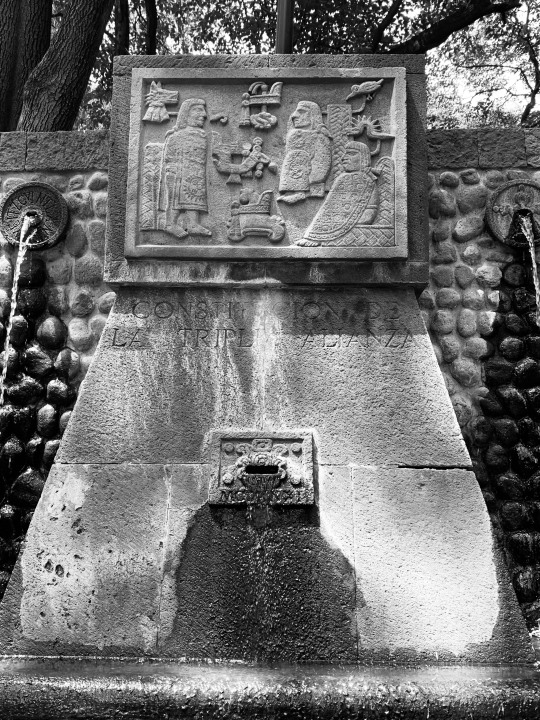
Nezahualcoyotl survives today not just in history, but in his writing. He is considered to be one of the greatest poets of ancient Mexico. The royalty and nobility of the Triple Alliance were expected to be well educated in many subjects, and nobles were taught how to use both the pen and the sword. There are some historical parallels with the samurais of Japan and the scholarly nobles of ancient Greece and Rome. It is amazing that we still have access to his poems, considering that poetry and literature at that time was often times memorized and reproduced orally, as well as the fact that there was great literary and cultural destruction by the Spanish in the generations after the Conquest.
Here is an excerpt of a poem written by Nezahualcoyotl, perhaps reflecting on his own experience of war and reconquest:
The battlefield is the place: where
one toasts the divine liquor in war,
where are stained red the divine
eagles,
Where the tigers howl,
Where all kinds of precious stones
rain from ornaments,
where wave headdresses rich with
fine plumes,
where princes are smashed to bits.
Here is another excerpt of a poem that is kind of like a pre-modern take on “these are a few of my favorite things”:
I love the song of the mockingbird,
bird of four hundred voices;
I love the color of jade
and the drowsy perfume of flowers;
but more than these, I love
my fellow human beings.
In recent years, as Mexico has strived to decolonize their national identity and intentionally celebrate their long ignored indigenous roots, Nezahualcoyotl has been frequently honored as a wise and fair ruler in Mexican history. There is a neighborhood named after him in Mexico City that, true to the character of the man, is home to many artists. He is even honored with his likeness on the 100 peso bill.
But I imagine the actual man would take all this recognition in stride. Like another poet who once famously wrote “nothing gold can stay”, Nezahualcoyotl also wrote about the impermanence and ever changing nature of life:
Truly do we live on earth?
Not forever on earth; only a little while here.
Although it be jade, it will be broken,
Although it be gold, it is crushed,
Although it be quetzal feather, it is torn asunder.
Not forever on earth; only a little while here.

#travelgram#mexico#cdmx#historiamexicana#mexicanhistory#aztec#poesiamexicana#mexicanpoetry#poetry#literature#triplealliance#triplealianza#parks#texcoco#history
3 notes
·
View notes
Text

¡¡Buenas, buenas gente!! Cómo están? Yo espero que muy bien, aquí les traigo un dibujito de Imperio Azteca que siendo sincera fue mi primera ves haciendo músculos y me gustó el resultado.
.
.
.
.
.
.
.
Les platicaré un poquito de por qué hice este dibujo y una de las razones fue que estaba planeado para un proyecto futuro que estaba haciendo pero hubo unos cambios de planes y no queria que este dibujo que me quedo uff se fuera a la basura así que se los muestro.
.
.
.
.
.
.
.
Y como queda un poco de falta de relleno, les contare un poco de esta cultura mesoamericana, así que prepárense para la pequeña clase de historia.
El Imperio azteca surgió en apenas 200 años, gobernó y colonizó la región central mesoamericana en una triple alianza entre los pueblos de Texcoco (acolhuas), Tlacopan (tepanecas) y México-Tenochtitlán. De hecho, Tenochtitlán fue la capital del Imperio completo
A partir de la alianza de las ciudades Tenochtitlán, Texcoco y Tlacopan, crearon un imperio centralizado y teocrático, gobernado por un tlatoani. Tenían una sociedad estratificada, dividida en tres grupos: pipiltin (nobles), macehualtin (gente común) y los esclavos.
La cultura mexica o azteca abarco el periodo comprendido entre el año 1325 D.C y 1521 D.C (casi dos siglos) hasta la llegada de los españoles y su conquista.
#countryhumans#countryhumans art#countryhumans america#historia#country humans#countryhumansimperioazteca
4 notes
·
View notes
Text
Blease click to see in full quality.

My take on the murder of the Tepanec ruler Maxtla of Azcapotzalco. Netzahualcoyotl having led the invasion is pictured hoisting his heart above in victory over his dead body on the cities sacrificial stone. Netzahualcoyotl was a Texcoco ruler who after this victory formed an alliance with Tenochtitlan and Tlacopan to form the 3 alliances (known mainly as the Aztec today) What I would give to be able to witness this moment and see Nezahualcoyotls victory in this moment. More info below cut
If you are interested in finding more about the history behind this this video is great (the entire channel is rlly good)
youtube
#my art#2d art#meso american stuff#gore#tw gore#blood#tw blood#aztec#texcoco#nezahualcóyotl#if this needs more tags please tell me I will#Youtube
6 notes
·
View notes
Text

The Aztec Empire or the Triple Alliance (Classical Nahuatl: Ēxcān Tlahtōlōyān, [ˈjéːʃkaːn̥ t͡ɬaʔtoːˈlóːjaːn̥]) was an alliance of three Nahuaaltepetl city-states: Mexico-Tenochtitlan, Tetzcoco, and Tlacopan. These three city-states ruled that area in and around the Valley of Mexico from 1428
The alliance waged wars of conquest and expanded after its formation. The alliance controlled most of central Mexico at its height, as well as some more distant territories within Mesoamerica, such as the Xoconochco province, an Aztec exclave near the present-day Guatemalan border. Aztec rule has been described by scholars as "hegemonic" or "indirect".[6] The Aztecs left rulers of conquered cities in power so long as they agreed to pay semi-annual tribute to the alliance, as well as supply military forces when needed for the Aztec war efforts. In return, the imperial authority offered protection and political stability and facilitated an integrated economic network of diverse lands and peoples who had significant local autonomy.
Aztec religion was a monistic pantheism in which the Nahua concept of teotl was construed as the supreme god Ometeotl, as well as a diverse pantheon of lesser gods and manifestations of nature. The popular religion tended to embrace the mythological and polytheistic aspects, and the empire's state religion sponsored both the monism of the upper classes and the popular heterodoxies.
The empire even officially recognized the largest cults such that the deity was represented in the central temple precinct of the capital Tenochtitlan. The imperial cult was specifically that of the distinctive warlike patron god of the Mexica Huitzilopochtli. Peoples were allowed to retain and freely continue their own religious traditions in conquered provinces so long as they added the imperial god Huitzilopochtli to their local pantheons.
By the reign of Ahuitzotl, the Mexica were the largest and most powerful faction in the Aztec Triple Alliance.
Building on the prestige the Mexica had acquired over the course of the conquests, Ahuitzotl began to use the title "huehuetlatoani" ("Eldest Speaker") to distinguish himself from the rulers of Texcoco and Tlacopan. The alliance still technically ran the empire. But the Mexica Emperor now assumed nominal if not actual seniority.
Ahuitzotl was succeeded by his nephew Moctezuma II in 1502. Moctezuma II spent most of his reign consolidating power in lands conquered by his predecessors.In 1515, Aztec armies commanded by the Tlaxcalan general Tlahuicole invaded the Purépecha Empire once again.The Aztec army failed to take any territory and was mostly restricted to raiding. The Purépecha defeated them and the army withdrew.
Moctezuma II instituted more imperial reforms.The death of Nezahualcoyotl caused the Mexica Emperors to become the de facto rulers of the alliance. Moctezuma II used his reign to attempt to consolidate power more closely with the Mexica Emperor.He removed many of Ahuitzotl's advisors and had several of them executed. He also abolished the quauhpilli class, destroying the chance for commoners to advance to the nobility. His reform efforts were cut short by the Spanish Conquest in 1519.
The Spanish expedition leader Hernán Cortés landed in Yucatán in 1519 with approximately 630 men (most armed with only a sword and shield).
Eventually, the Spanish-led army assaulted the city both by boat and using the elevated causeways connecting it to the mainland. The attackers took heavy casualties, although the Aztecs were ultimately defeated. The city of Tenochtitlan was thoroughly destroyed in the process. Cuauhtémoc was captured as he attempted to flee the city. Cortés kept him prisoner and tortured him for a period of several years before finally executing him in 1525.
6 notes
·
View notes
Text


La Noche Triste
Event during the Conquest of Mexico
La Noche Triste ("The Night of Sorrows", literally "The Sad Night") was an important event during the Spanish conquest of the Aztec Empire, wherein Hernán Cortés, his army of Spanish conquistadors, and their native allies were driven out of the Aztec capital, Tenochtitlan.
Quick Facts Date, Location ...
Prologue
Cortés' expedition arrived at Tenochtitlan on November 8, 1519, taking up residence in a specially designated compound in the city. Soon thereafter, suspecting treachery on the part of their hosts, the Spaniards took Moctezuma II, the Aztec king or Tlatoani, hostage. Though Moctezuma followed Cortés' instructions in continually assuring his subjects that he had been ordered by the gods to move in with the Spaniards and that he had done so willingly, the Aztecs suspected otherwise. During the following 98 days, Cortés and his native allies, the Tlaxcaltecs, were increasingly unwelcome guests in the capital.
Cortés heads off Spanish punitive expedition
In June 1520, news from the Gulf coast reached Cortés that a much larger party of Spaniards had been sent by Governor Velázquez of Cuba to arrest Cortés for insubordination. Leaving Tenochtitlan in the care of his trusted lieutenant, Pedro de Alvarado, Cortés marched to the coast, where he defeated the Cuban expedition led by Pánfilo de Narváez sent to capture him. When Cortés told the defeated soldiers about the riches of Tenochtitlan, they agreed to join him. Reinforced by Narvaez's men, Cortés headed back to Tenochtitlan.
Loss of control in Tenochtitlan
During Cortés's absence, Pedro de Alvarado ordered a preemptive slaughter of Aztec nobles and priests celebrating a festival in the city's main temple. In retaliation, the Aztecs laid siege to the Spanish compound, in which Moctezuma was still being held captive. By the time Cortés returned to Tenochtitlan in late June, the Aztecs had elected a new Tlatoani named Cuitláhuac.
Cortés ordered Moctezuma to address his people from a terrace in order to persuade them to stop fighting and to allow the Spaniards to leave the city in peace. The Aztecs, however, jeered at Moctezuma, and pelted him with stones and darts. By Spanish accounts, he was killed in this assault by the Aztecs, though the Aztecs claim he had been killed instead by the Spanish.: 294 : 90
A map of Tenochtitlan and its causeways leading out of the capital
With Moctezuma dead, Cortés and Alvarado knew they were in a precarious position. Under constant attack, with gunpowder, food, and water in short supply, Cortés decided to break out of the city by night. In order to put the Aztecs off their guard, he sent messengers asking for a one-week ceasefire, at the end of which the Spaniards would return any treasure of which they were in possession and would be permitted to leave the city peacefully.: 296
Since the Aztecs had damaged bridges on four of the eight causeways into the island city, the Spaniards devised a portable bridge they could use in order to cross any unspanned sections of water. Cortés ordered that as much of the accumulated gold and other booty as was feasible be packed and carried away, and invited the Spanish soldiers to take and carry away as much as they wished of the remainder. This invitation would lead to the demise of many soldiers who, overburdened with treasure, found it impossible to navigate the causeways and other obstacles encountered on the way out of the city.: 297, 306
Cortés ultimately would have to choose among three land routes: north to Tlatelolco, which was the least dangerous path but required the longest trip through the city; south to Coyohuacan and Iztapalapa, two towns that would not welcome the Spanish; or west to Tlacopan, which required the shortest trip through Tenochtitlan, though they would not be welcome there either. Cortés selected the western causeway to Tlacopan, needing the quickest route out of Tenochtitlan with all his provisions and people.
The Spanish head for the causeway out
On the night of July 1, 1520, Cortez's large army left their compound and headed west, toward the Tlacopan causeway. The causeway was apparently unguarded, and the Spaniards made their way out of their complex unnoticed, winding their way through the sleeping city under the cover of a rainstorm. Before reaching the causeway, they were noticed by Aztec warriors known as the Eagle Warriors, who sounded the alarm.: 298, 305 [discuss] The alarm was then shouted by others, first by a woman drawing water, and then by the priest of Huītzilōpōchtli from atop Templo Mayor.: 85
As the alarm spread, numerous Aztec warriors, noblemen and commoners alike, emerged from their houses and began attacking the Spaniards at every direction from their canoes or on the causeway with macuahuitl swords, spears, arrows, and stones thrown from slings. The fighting was ferocious. As the Spaniards and their native allies reached the causeway, hundreds of canoes appeared in the waters alongside to harry them. The Spaniards fought their way across the causeway in the rain. Weighed down by gold and equipment, some of the soldiers lost their footing, fell into the lake, and drowned. Amid a vanguard of horsemen, Cortés pressed ahead and reached dry land at Tacuba, leaving the rest of the expedition to fend for itself in the treacherous crossing.: 299–300
Seeing the wounded survivors straggle into the village, Cortés and his horsemen turned back to the causeway, where they encountered Pedro de Alvarado, unhorsed and badly wounded, in the company of a handful of Spaniards and Tlaxcaltecs. According to Bernal Díaz del Castillo, it was at this point that tears came to Cortés' eyes, as he realized the extent of the debacle.: 300
Cortés, Alvarado and the strongest and most skilled of the men had managed to fight their way out of Tenochtitlan, although they were all bloodied and exhausted. Cortés himself had been injured in the fighting. All of the artillery had been lost, as had most of the horses.: 302
The sources are not in agreement as to the total number of casualties suffered by the expedition. Cortés himself claimed that 154 Spaniards were lost along with over 2,000 native allies. Thoan Cano, another eyewitness to the event, said that 1170 Spaniards died, but this number probably exceeds the total number of Spaniards who took part in the expedition. Francisco López de Gómara, who was not himself an eyewitness, estimated that 450 Spaniards and 4,000 allies died.
Montezuma's son, Chimalpopoca was killed; Tepanec prince Tlaltecatzin,: 87 King Cacamatzin, his three sisters and two brothers were also killed.: 90
Diaz states the Spaniards suffered 860 soldiers killed, which included those from the later Battle of Otumba. The Tlaxcaltecs lost a thousand. The noncombatants attached to the expedition suffered terribly, 72 casualties, including five Spanish women. The few women who survived included La Malinche the interpreter, Doña Luisa, and María Estrada.: 302, 305–306 The event was named La Noche Triste ("The Night of Sorrows") on account of the sorrow that Cortés and his surviving followers felt and expressed at the loss of life and treasure incurred in the escape from Tenochtitlan.
Aftermath
Further battles awaited the Spaniards and their allies as they fought their way around the north end of Lake Zumpango. One week later, at the Battle of Otumba, not far from Teotihuacan, they turned to fight the pursuing Aztecs, decisively defeating them — according to Cortés, because he slew the Aztec commander — and giving the Spaniards a small respite that allowed them to reach Tlaxcala.: 303–305
It was in Tlaxcala that Cortés planned the siege of Tenochtitlan and the eventual destruction of the Aztec Empire.
5 notes
·
View notes
Note
What is your personal opinion about the personality of Spain as it is now and before? Do you send it with someone? I want to know more about Latin American characters like Mexico (personality, its people, if he is a native American or not, what are his thoughts with colonization and how he lives his life today...headcanons) ❤️🙈 i'm sorry and thank you so much
I hope I am understanding this correctly but I am assuming this is about how I headcanon Antonio's personality now compared to the past and my HCs with my Mexico OC
So as for Antonio. I headcanon his personality to be a lot more mellowed out than it was before. He's not nearly as violent as he used to be. He's also not nearly as insecure in his masculinity as he was in the past (I HC Antonio to be trans and have huge masculinity issues). However, he is still an asshole in my opinion. Given that the country of Spain itself does not seem to find any shame in their acts of colonialism, the way that I write Spain is that he typically doesn't either.
Yes, he definitely regrets a lot, but he himself does genuinely believe that he did Latin America a favor. Pride and ego plague him. He is a man with hubris. Because of this, apologies do not exist in his vocabulary. You're better off just asking anyone else for an apology because it won't come from him.
It's a bit hypocritical of him honestly. Because he views the Age of Exploration as an unhappy time and it's a big part of why my interp of Antonio gets antsy when his hair starts to get long. He cannot stand his hair getting long anymore as it reminds him of times he prefers to forget. Despite this, he does not seem to think about that time being unpleasant to the others around him.
Antonio doesn't seem to see the irony in this. If it's pointed out, he denies it. Or he makes up plenty of excuses. Like I said, he's hypocritical. He refuses to see it too.
He's very much someone who is two-faced. And this has been a recent development as he used to be just very transparent with everyone regardless of the consequences. However, you're only likely to get what he genuinely thinks and believes if you're one of his close friends. And he has very few of those. Francois, Gilbert, Portugal, and Lorenzo are the only people who genuinely see every side of him. Belgium and Netherlands I headcanon see it too, but he does still put up walls with him.
Antonio thinks it's easier that way. He's a lot more reserved than he lets others know and puts up a smile when he's able to. Letting people in is dangerous and letting his thoughts out is too. So it's better to hide it all.
NOW, as for my Mexico.
There's a lot of headcanons there but I will share some of the basic stuff. You can ask me for more any time!
My Mexico is the same as my Tlacopan OC. Now I do want to clarify something. I used to have my Tlacopan, Tenochtitlan, and Tetzcoco as triplets. This is because those OCs are not originally Hetalia OCs they're for a video game I'm working on where they are triplets. However, this doesn't make sense in the context of Hetalia due to histories. So they are simply siblings in the context of Hetalia and NOT triplets. Someone sent me an ask about that a while ago and I wanted to clarify.
SO, the reason that it is my Tlacopan OC as Mexico versus Tenochtitlan is because Xochitl is considered the safest option to her government. Because Tematlalehua (Tenochtitlan) is disabled, they don't want her representing the government. And because Huitzilihuitl (Tetzcoco) is openly gay and refuses to Hispanicize more than necessary, they don't find him to be a good option either. Thus, Xochitl (Tlacopan) was made into the representative of Mexico.
She is Nahua. So she is Indigenous. She is very proud of this fact despite everything that has happened to her and the government's continued efforts to erase Indigenous presence in Mexico.
Colonization was very hard for her. It destroys her home and she was already an adult at the time of everything happening. So she was an adult watching her siblings suffer and their people suffer. For this, she absolutely despises Antonio and refuses to play nice with him more than she has to diplomatically. But even then, she's cold towards him and does not give him the time of day.
My Mexico also does not have a good relationship with Alfred(when he is white because I love black/Native Alfred and that would change their dynamic). Their history is way too complicated and extensive with lots of bullshit, subjugation, and screwing over from Alfred.
Xochitl is otherwise a very motherly figure or an older sister type. She practices folk Catholicism and her teotl is Coatlicue. She's very sweet, loves to cook for her loved ones, and is always an open ear when something is wrong. She has a house full of little ceramic chickens. Just very Señora energy.
Xochitl is very dear to me. I love her so much. There's a lot that I could talk about with her but I need something to start with because there's just so much. I'm more than happy to talk about her because she is my beloved.
22 notes
·
View notes
Note
🌻 :-)
Neither the aztec empire of the mayan empire technically exist.
The aztec empires proper name is the triple alliance between the city states of tenochtitlan tlacopan and texcoco. Tenochtitlan is what most people mean when they say aztec tho. Tenochtitlan is now mexico city.
Mayan is the improper term as maya are the people and they were never a united empire but more a broad swathe of empires and city states. Kinda like how ancient italy wasnt unified but city states like venice, rome, etc. Mayan refers to the languages spoken in the area which form an entire language tree. While were at it people say the fall of the maya which is incorrect because yes many maya city states fell ajd entire areas fell into decay, however multiple cities prospered after the classic era.
Bonus fact: you might also know of the tarascan empire of michoacan one of the few empires who stood up against the triple alliance. Tarascan is considered a sort of slur and was the name given to them by the spanish. Proper term is purépecha. (These guys are interesting in that they had pretty sophisticated metal work and are a language isolate)
Also because i remembered Inca is the spanish term, Inka is the indigenous spelling
4 notes
·
View notes